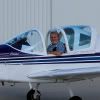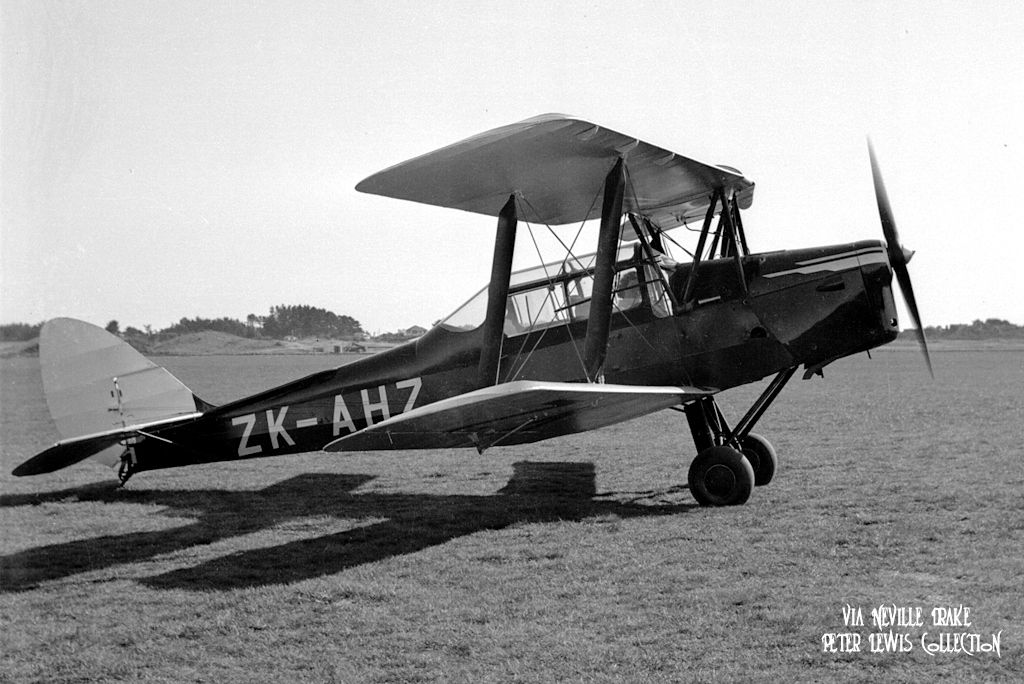Post by Dave Homewood on Jul 18, 2021 23:00:11 GMT 12
FATHER AND SON SURVIVE CRASH OF AIRCRAFT AND EMERGE FROM BUSH AFTER ORDEAL OF 10 DAYS
(P.A.) WANGANUI, Jan. 9.
The Tiger Moth aircraft ZK-AHZ which went missing on a flight from Wanganui to New Plymouth on the afternoon of December 29 has been found. Both occupants are safe.
The plane was piloted by Cadet Pilot Ian Palmer, aged 19, of the R.N.Z.A.F. station, Wigram, and he had as passenger his father, Mr. Oswald Palmer, aged 48, of Victoria St., Onehunga, Auckland.
The aircraft left Wanganui at 2 p.m. on Thursday, December 29 and experienced heavy rain and there was a very low cloud ceiling. It crashed at the top end of the Waitotara Valley in hilly country covered with thick bush and is believed to be a total loss.
Mr. Palmer and his son scrambled out from the wreckage. They were considerably jarred by the crash.
Ian Palmer had a cut across one eye and his father a cut across the bridge of his nose. The father also received an injury to a shoulder when the harness in the cockpit broke.
They obtained the emergency first aid kit from the plane and, after thoroughly washing their wounds with water from a spring, dressed them properly.
They then set about getting out and reaching civilisation. The rain had ceased, but it was still very misty.
“We started out 24 minutes after the crash,’’ said Ian Palmer in a telephone interview yesterday. “The going was very tough and through heavy bush country. We had a lot of trouble following a stream. In some places we had to swim: at others we had to make wide detours to avoid waterfalls which were impassable.”
Lived Six Days on Berries
For the first six days neither had anything to eat except bush berries. They kept moving steadily on and at 2.30 yesterday afternoon they reached Kapara sheep station, 60 miles from Wanganui.
Their clothing was in rags. Their footwear was slashed to pieces and they were footsore and ready to drop. A warm welcome was accorded them by the manager of the station, Mr. Boswell, who attended to their immediate needs and advised the Waitotara and Wanganui police. Arrangements were made by the R.N.Z.A.F station, Ohakea, to bring both men out, but because of their trying experience it was likely they would stay the night at the Kapara station homestead.
In a telephone interview with the Wanganui Chronicle from there last evening, Mr. Oswald Palmer said that he and his son had had a very trying experience. “It was the weather that beat us,” he said, referring to the crash. “There was heavy rain and thick cloud which was very low.”
Crash Into Ravine
Ian Palmer said that the ceiling was about 1500 ft. and the aircraft stalled as he was trying to fly over a high ridge. The machine had insufficient height and crashed into a tree falling down the side of a cliff into a ravine.
After the first six days they reached a small hut in a clearing where they found one piece of toast left by a pig-hunter or bushman a short time previously. They shared the toast.
“That was all we could eat,” said Mr. Palmer. “We were full and had to go and lie down for a while. Someone had been at the shack about a month before and had left half a loaf of bread, half a tin of raspberry jam, about half a pound of butter, still eatable, a small piece of cheese, some powdered milk and a little bit of sugar.
“We made these rations last out another four days and supplemented them with some apples we found on a tree near the shack. They were green, but we had them boiled, baked and fried until we were heartily tired of them. The shack also provided us with a stock of matches, but there were still no blankets.
Aircraft Sighted
"On our second day at the hut an aircraft came overhead,” Mr. Palmer recalled. “We had heard a plane the day after the crash but we could not see it as we were so far down in the bush. However, this one, we thought, seemed to see us. It was an Air Force Harvard and it circled around and dived over us. We signalled to it with a mirror and white towel. It went away. It did not come back, although we waited another day at the shack. Later on the same day, I saw another plane which might have been a Whitney Straight. It was a long way off.
“We stayed three days at the shack. This morning we decided it was time to move on. After about four miles of walking we came out of the bush. It was still very hilly and rough and there was no sign of any house. That was two miles further on.
“After the first six days without food we felt very weak,” Mr. Palmer added, “but we are all right now.”
Four days after their arrival at the hut they reached Kapara station, which is eight miles above Ngamatapouri on the Waitotara River. One hundred and sixty-six hours had elapsed between the time they had last had a meal and when they came upon the meagre piece of toast in the bushman’s hut.
In all they had spent 10 trying days in some of the roughest country in New Zealand.
GISBORNE HERALD, 9 JANUARY 1950
(P.A.) WANGANUI, Jan. 9.
The Tiger Moth aircraft ZK-AHZ which went missing on a flight from Wanganui to New Plymouth on the afternoon of December 29 has been found. Both occupants are safe.
The plane was piloted by Cadet Pilot Ian Palmer, aged 19, of the R.N.Z.A.F. station, Wigram, and he had as passenger his father, Mr. Oswald Palmer, aged 48, of Victoria St., Onehunga, Auckland.
The aircraft left Wanganui at 2 p.m. on Thursday, December 29 and experienced heavy rain and there was a very low cloud ceiling. It crashed at the top end of the Waitotara Valley in hilly country covered with thick bush and is believed to be a total loss.
Mr. Palmer and his son scrambled out from the wreckage. They were considerably jarred by the crash.
Ian Palmer had a cut across one eye and his father a cut across the bridge of his nose. The father also received an injury to a shoulder when the harness in the cockpit broke.
They obtained the emergency first aid kit from the plane and, after thoroughly washing their wounds with water from a spring, dressed them properly.
They then set about getting out and reaching civilisation. The rain had ceased, but it was still very misty.
“We started out 24 minutes after the crash,’’ said Ian Palmer in a telephone interview yesterday. “The going was very tough and through heavy bush country. We had a lot of trouble following a stream. In some places we had to swim: at others we had to make wide detours to avoid waterfalls which were impassable.”
Lived Six Days on Berries
For the first six days neither had anything to eat except bush berries. They kept moving steadily on and at 2.30 yesterday afternoon they reached Kapara sheep station, 60 miles from Wanganui.
Their clothing was in rags. Their footwear was slashed to pieces and they were footsore and ready to drop. A warm welcome was accorded them by the manager of the station, Mr. Boswell, who attended to their immediate needs and advised the Waitotara and Wanganui police. Arrangements were made by the R.N.Z.A.F station, Ohakea, to bring both men out, but because of their trying experience it was likely they would stay the night at the Kapara station homestead.
In a telephone interview with the Wanganui Chronicle from there last evening, Mr. Oswald Palmer said that he and his son had had a very trying experience. “It was the weather that beat us,” he said, referring to the crash. “There was heavy rain and thick cloud which was very low.”
Crash Into Ravine
Ian Palmer said that the ceiling was about 1500 ft. and the aircraft stalled as he was trying to fly over a high ridge. The machine had insufficient height and crashed into a tree falling down the side of a cliff into a ravine.
After the first six days they reached a small hut in a clearing where they found one piece of toast left by a pig-hunter or bushman a short time previously. They shared the toast.
“That was all we could eat,” said Mr. Palmer. “We were full and had to go and lie down for a while. Someone had been at the shack about a month before and had left half a loaf of bread, half a tin of raspberry jam, about half a pound of butter, still eatable, a small piece of cheese, some powdered milk and a little bit of sugar.
“We made these rations last out another four days and supplemented them with some apples we found on a tree near the shack. They were green, but we had them boiled, baked and fried until we were heartily tired of them. The shack also provided us with a stock of matches, but there were still no blankets.
Aircraft Sighted
"On our second day at the hut an aircraft came overhead,” Mr. Palmer recalled. “We had heard a plane the day after the crash but we could not see it as we were so far down in the bush. However, this one, we thought, seemed to see us. It was an Air Force Harvard and it circled around and dived over us. We signalled to it with a mirror and white towel. It went away. It did not come back, although we waited another day at the shack. Later on the same day, I saw another plane which might have been a Whitney Straight. It was a long way off.
“We stayed three days at the shack. This morning we decided it was time to move on. After about four miles of walking we came out of the bush. It was still very hilly and rough and there was no sign of any house. That was two miles further on.
“After the first six days without food we felt very weak,” Mr. Palmer added, “but we are all right now.”
Four days after their arrival at the hut they reached Kapara station, which is eight miles above Ngamatapouri on the Waitotara River. One hundred and sixty-six hours had elapsed between the time they had last had a meal and when they came upon the meagre piece of toast in the bushman’s hut.
In all they had spent 10 trying days in some of the roughest country in New Zealand.
GISBORNE HERALD, 9 JANUARY 1950














